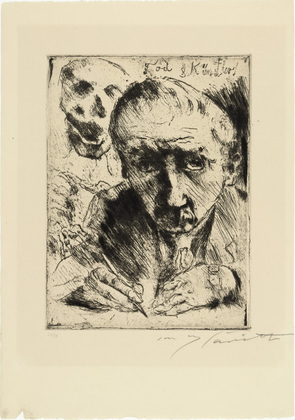
Art and Devastation: A Tour of German Post-War Expressionism #2
Lovis Corinth, Death and the Artist, 1921. Etching and drypoint. MoMA.
In post-war Germany, death became a dominant theme in the art world. Corinth was near the end of his prolific life when he made this etching for the portfolio, Dance of Death. Academically trained in Munich and Paris, he made over 1200 prints, in addition to paintings that interacted with both Impressionism and Expressionism. This self-portrait comes after a stroke had paralyzed his left hand, leaving his right hand with tremors. Corinth is dressed formally in winged collar and tie, his eye fixed on the viewer, and his watch prominent on his left wrist. The hatching in his face and jacket points toward the skull beyond his right shoulder. Ever the shape of Corinth’s head seems distorted, as if it’s being sucked toward death.
Art could warn of impending death. Art could dramatize death. It just couldn’t stop it.
